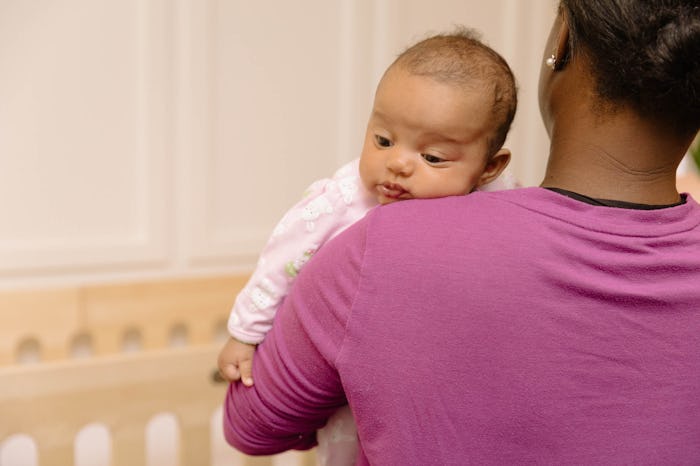While feeding your baby sounds like a simple enough task, it rarely is. When a baby feeds, they end up swallowing a lot of air. And if you don't burp them, they're bound to become irritable, uncomfortable, and may have excess gas. If you're a new parent, and you're pretty overwhelmed by the whole "taking care of another human being thing, it's common to ask yourself: "How hard do I burp my baby?" After all, just because you've decided to become a parent, doesn't mean the job is innate.
Dr. Shalini Forbis, M.D., a pediatrician and a Dr. Mom Squad blogger for Dayton Children's Hospital in Ohio, tells Parents that caretakers should "pat your baby on the back, gently for a minute or so," adding that, "for newborns, make sure you are supporting the head and neck." Newborns look delicate, and they are, which is why support is crucial, but you also need the kind of light-but-firm touch that will expel the gas from your baby before they become fussy and uncomfortable. Because the air typically sits in the esophagus in most newborns up to 2-months-old, the American Academy of Pediatrics recommends burping your infant regularly, even if he or she doesn't show any initial signs of discomfort or unpleasantness. In the end, there's no way of knowing exactly how much air they're holding in their tiny bellies.
In order to know how "hard" to burp your baby, you should first be sure you're in the correct burping position. Parenting suggests you first try placing the baby over your shoulder or on your lap. You'll want to angle them slightly forward while, again, supporting his or her chest and chin in your hand. You can also lay your baby face down across your lap, with their head resting on your thigh. The key, however, and with this particular move, is to be sure the baby's head is higher than the stomach, otherwise the air can't make it's way out. Once you've found a good position that works for the both of you, use your fingertips or a flat palm to tap your baby's back. If, after a few minutes, nothing comes up, give it a rest and try again later. There may not be any gas trapped for your baby to burp out. It's worth trying different positions before moving on entirely, just so you can make sure your baby doesn't have any gas trapped inside their tiny little bodies.
Pregnancy & Newborn Magazine's website says strong, steady taps work best. You can also introduce rubbing in circular motions from the lower back, working your way to the top, continuing to use a firm but gentle hand. For the first couple of months, the same magazine advises that you stop mid-feeding to burp your baby, to prevent a buildup of gas (which can be painful). It's also worth noting that while you should have a slight firmness to the patting, never shake your baby. Not only will it not help with the gas, but it can cause serious neurological damage.
Gassiness, however common in infants, is the result of trapped air, so it's also important to pinpoint how air becomes trapped inside your little one. The Bump suggests the air can come from drinking too quickly, too slowly, or they're feeding with air bubbles present. Dr. William Sears, pediatrician and author of over 30 parenting books, says "If breastfeeding, be sure baby’s lips form a good seal far back on the areola." And for formula, Dr. Sears says, "If bottle feeding, be sure baby’s lips are positioned on the wide base of the nipple, not just on the tip."
If your baby still seems fussy, take a break by lying them on your lap, change positions, the resume a feeding and/or your activity if no gas has come up yet. In the end, and always, patience is key. Don't let the lack of burping derail or frustrate you. If you continue patting and rubbing with the correct positioning, it'll happen eventually and your baby will, hopefully, feel better.
Check out Romper's new video series, Romper's Doula Diaries:
Watch full episodes of Romper's Doula Diaries on Facebook Watch.
